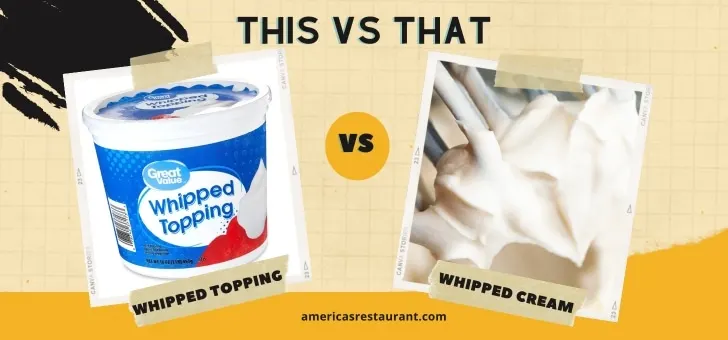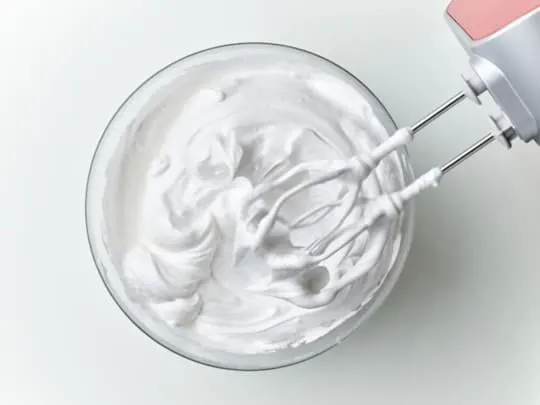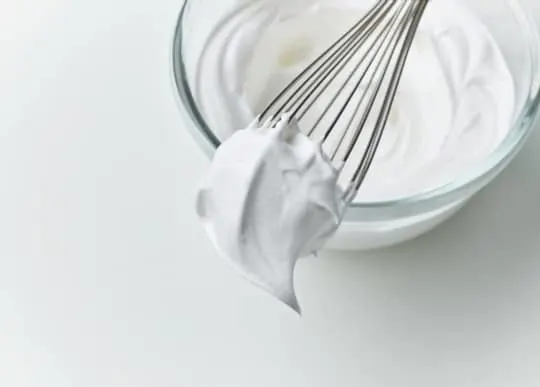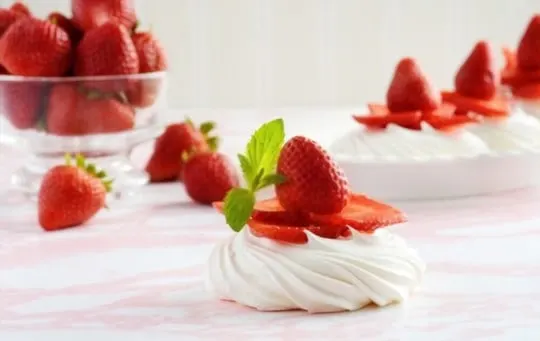Whipped topping and whipped cream sit on opposite sides of the dessert battlefield. Both claim the crown of creamy goodness.
We slide into this debate armed with spoons and a love for all things fluffy. Whipped topping, known for its shelf stability, beckons the convenience lovers. In the other corner, whipped cream flaunts its rich, authentic flavor profile.
We’ve all been there, hovering over pies and hot cocoa, making the critical choice. Our grandmas swore by the real deal; we sometimes reach for the tub. It’s a clash of titans, folks. Who will take the cake? Or, more accurately, top it.

What is Whipped Topping?

The creamy delight that tops our desserts has always been a popular indulgence.
Whipped topping, otherwise known as non-dairy topping, is a substitute for whipped cream and is commonly used as a quick alternative.
It is made by blending water, hydrogenated vegetable oil, corn syrup, and high fructose corn syrup.
The added stabilizers prevent the topping from losing air and solidifying during storage.
Although it tastes similar to whipped cream, there are significant differences in nutrition and texture between the two toppings.
Whipped toppings tend to have fewer calories than whipped cream and are cholesterol-free making them an excellent option for those who have dietary restrictions or are health conscious.
However, they also contain trans fats and have less nutritional value than whipped cream obtained by whipping heavy or double cream.
The process of whisking heavy cream creates a thick, fluffy consistency with a richer flavor compared to its artificial counterpart.
It’s important to be aware of the differences in taste, texture, and nutritional composition when choosing between the two toppings.
While whipped topping may be an immediate solution for some recipes, it cannot provide the same level of richness as real whipped cream can offer.
The choice between whipped topping and whipped cream depends mainly on an individual’s dietary requirements and preferences.
Nevertheless, one must realize that even though both toppings serve almost the same purpose; they possess distinct qualities that make them unique in their own way.
What is Whipped Cream?

Whipped cream is a light and fluffy topping made by whipping heavy cream until it doubles in volume and forms peaks.
Cream contains mostly milk fat, which when whipped aerates and expands, resulting in a delightful texture.
It can be served as a topping for desserts such as pies or cakes and beverages like hot chocolate or coffee.
Whipped cream can be further enhanced by sweetening it with sugar or adding vanilla extract for flavor.
This variant of whipped cream is commonly referred to as Chantilly Cream.
Additionally, non-dairy substitutes like coconut cream can be used for those who are lactose intolerant or prefer plant-based options.
Whipped cream has lower sugar content than whipped toppings, which makes it an ideal choice for those who want to control their sugar intake.
Furthermore, since Whipped Cream is natural and made only from heavy cream, there are minimal preservatives added to the mix unlike most whipped toppings that are filled with chemicals and other additives.
Differences Between Whipped Topping and Whipped Cream

Whipped topping and whipped cream are two dairy products used as dessert toppings.
Whipped topping is made using hydrogenated vegetable oil while whipped cream is made from fresh heavy cream.
Their taste, appearance and nutritional value differ significantly.
Furthermore, whipped cream may be costly, has higher calorie content, and cannot stay in shape for long, while in contrast whipped topping is cheaper, low-calorie option that lasts longer when refrigerated.
Ingredients Used
Many recipes call for various ingredients, and it can be confusing to choose which one to use.
Here, we will discuss the differences between whipped topping and whipped cream to help you decide which one is the better option.
Whipped topping is a non-dairy product made from hydrogenated vegetable oil and sweeteners.
It is often used as a substitute for whipped cream because it gives a similar taste and texture but with fewer calories and fat.
However, it contains additives that may not be suitable for everyone, and it may not whip up as easily as real cream.
On the other hand, whipped cream is a dairy product made from heavy cream that is prepared by whipping with sugar until soft peaks form.
It has a rich flavor and smooth texture that cannot be beaten by any substitute.
Real whipped cream may contain more calories than its non-dairy counterpart but provides more nutritional value.
It’s important to consider your personal requirements when deciding on which to use.
If you’re sensitive to dairy or want to watch your calorie intake, then whipped topping may be the better choice for you.
But if you’re after richer flavor or no dietary restrictions, then go ahead with whipped cream without guilt.
Texture and Stability
The consistency and firmness of whipped cream and whipped topping are key factors to consider when choosing which one to use.
While both add a lovely fluffy texture to desserts, the two toppings have slightly different consistencies.
When it comes to stability, whipped topping is undoubtedly more stable than whipped cream.
Due to its composition, it does not break down as quickly as whipped cream, making it a more reliable option for recipes that require longer periods before serving.
In terms of texture, while both toppings produce a similar look, their feel in the mouth is different.
Whipped cream tends to be lighter and feels silkier on the tongue.
On the other hand, whipped topping feels denser and richer when tasted due to its added stabilizers.
This density can often make it feel heavy on the palate.
Using whipping cream rather than whipping topping will provide unique taste experience due to its soft texture and smoothness of flavor without any artificial ingredients.
But when it comes to stability, especially in warm weather or dishes that need long hours before being served, then whipped topping is your best bet because it won’t deflate easily or separate after some time like whipped cream would do.
So, whether you choose whipped cream or whipped topping depends on what you want your final product’s consistency and texture to be like and how long you want your dish to sit before serving.
Using this knowledge will ensure that whatever choice you make turns out perfectly.
Taste and Flavor
The sensory experience of whipped topping and whipped cream varies greatly.
Whipped cream has a natural, rich and creamy flavor while whipped topping can taste slightly artificial, lighter and occasionally sweeter.
When it comes to which one is better, it ultimately depends on personal preference and the specific purpose.
Whipped cream tends to be preferred for its more traditional and natural flavor profile.
It pairs well with berries, fruit salads, pies, and hot beverages like coffee or hot chocolate.
On the other hand, whipped topping may be a better option for those who prefer a lighter alternative or need a long shelf-life product for convenient use.
It’s important to note that there are variations in quality between different brands and types of each product, so experiment with different options to find the ideal choice for your needs and preferences.
Ultimately though, both have their unique benefits that can add value to your desserts or beverages.
Sweetness Level
The level of sweetness in whipped topping and whipped cream depends on the brand and type used.
Some brands offer a lighter, less sweet version, while others may contain more sugar for a sweeter taste.
It’s essential to consider the level of sweetness in both when deciding which one to choose for your dessert recipe.
When comparing whipped topping vs.
whipped cream, it’s important to note that whipped cream typically has a smoother, creamier texture with a subtle sweetness.
Whipped topping, on the other hand, usually has a thicker consistency and offers more sweetness due to additional ingredients like corn syrup solids or high-fructose corn syrup.
It’s worth noting that some people prefer the sweeter taste of whipped topping over whipped cream.
Additionally, if you’re using either component as part of a complex dessert recipe with different flavors and textures, the sweetness factor may differ based on the overall combination.
Ultimately, whether you choose whipped topping or whipped cream depends on your personal preference for texture and level of sweetness.
It’s always best to conduct taste tests before making any decision so that you can set expectations and cater to individual preferences.
Similarities Between Whipped Topping and Whipped Cream

With regards to whipped cream and whipped topping, it’s important to understand that there are various similarities between them.
Both are used as a delicious and decorative way to add flair to different desserts, such as pies, cakes, sundaes and hot cocoa.
They are both made by mixing dairy products with sugar and whipping until they become light and fluffy.
Furthermore, both can also be purchased pre-made in stores for convenience.
However, it is crucial to note that there are some key differences between the two that discerning customers may want to take into account when creating delightful treats or indulging cravings.
Whipped topping is generally lighter in texture than whipped cream, containing less dairy fat content.
Some varieties may not have any perishable ingredients at all and instead opt for a combination of water, hydrogenated vegetable oils and high fructose corn syrup.
This composition allows whipped topping to retain its shape in the face of heat or moisture exceedingly well.
It also makes it a more stable alternative when you need something sturdier than whipped cream to use as decorations.
While whip cream remains the true classic with its luscious texture and fresh dairy content, it doesn’t hold up quite as nicely outside the fridge as stabilized options like whipped toppings.
Keep this fact in mind when you consider your specific needs—whipped cream for immediate consumption or refrigerating needs; stabilized toppings for ease of decorating/dessert designing/self-service preferences.
Usage and Culinary Applications
Whipped cream and whipped topping are two popular ingredients used in culinary applications, but which one is a better option? Whipped cream is made from heavy whipping cream, while whipped topping is a non-dairy alternative made from hydrogenated vegetable oil, corn syrup, and other additives.
Both have different uses and applications in the kitchen.
Whipped cream is great for desserts like pies, cakes, or as a topping for coffee or hot chocolate.
Its rich and natural flavor makes it perfect for gourmet recipes.
On the other hand, whipped topping has a stable structure that makes it ideal for filling pastries or decorating cakes.
It’s also used as a low-fat alternative to whipped cream.
One unique advantage of whipped topping is that it doesn’t deflate as fast as whipped cream because of its stabilizers.
This means you can use it for decorative purposes without worrying about it losing its shape quickly.
However, some people prefer whipped cream because of its natural taste and fewer artificial ingredients.
Overall, your choice between whipped cream and whipped topping should depend on the specific recipe you are making and your personal preference.
While both have different uses in the kitchen, they can be substituted for each other in most cases.
Experiment with both ingredients to find out which one works best for your culinary needs.
Nutritional Comparison between Whipped Topping and Whipped Cream
Whipped Topping and Whipped Cream have been the quintessential dessert toppings for years.
But, how do they compare nutritionally? Let’s analyze the nutrient profile of these luscious toppings to identify which one is a better option.
It’s important to note that both toppings have calories, but whipped topping has more calories and fat content than whipped cream due to its added vegetable oils.
On the other hand, whipped cream contains natural dairy fat but has slightly less sugar than whipped topping.
Hence, if we compare, whipped cream is a healthier choice for those who are counting their calorie intake.
Furthermore, some of the commercial products also come with artificial flavors and colors additives leading to more unhealthy factors in whipped topping compared to natural and organic whipped cream.
It is suggested that consumers should always check labels before making their purchase decisions.
Overall, it’s recommended to indulge in moderation and pay attention to nutritional values while consuming any food item- be it a treat or not.
Considerations for Dietary Restrictions and Preferences
When selecting between whipped topping and whipped cream, it’s crucial to consider dietary restrictions and preferences to avoid any health complications.
This consideration relates to individuals who are allergic or intolerant to specific ingredients such as dairy or gluten.
Whipped Topping is a suitable option for those with dairy allergies or lactose intolerance, as it is made of hydrogenated vegetable oil instead of milk.
In comparison, whipped cream is an ideal option for individuals who prefer natural and organic ingredients as they are aware of the source of every ingredient used in the preparation.
It’s also essential to note that individuals watching their calorie intake should opt for whipped topping as this product has low calories compared to whipped cream despite having similar textures.
Nevertheless, it’s advisable to check each product’s nutritional label before making a decision about which option will best meet your dietary needs.
In summary, selecting between whipped topping and whipped cream requires analyzing your dietary preferences and restrictions carefully.
Always check the products’ nutritional labels before purchase or use to ensure a healthy eating lifestyle.
Conclusion
The results are in – between whipped topping and whipped cream, which is the better option? While both serve the same purpose, there are some critical differences to keep in mind when making your choice.
Whipped topping typically consists of water, vegetable oil, and high-fructose corn syrup, whereas whipped cream is made from heavy cream and sugar.
In terms of taste and texture, whipped cream tends to be richer and more flavorful due to its components but it’s also higher in calories and fat content.
Moreover, when considering health benefits, real whipped cream provides essential vitamins like A and D that help improve bone density while dairy-free alternatives lack these nutrients.
Additionally, dairy-free options may contain additives or preservatives that negatively affect one’s health over time.
Ultimately, the decision between whipped topping vs.
whipped cream comes down to personal preference and nutritional goals.
Consider what ingredients align with your values and make an informed choice for your next dessert or coffee drink recipe.
